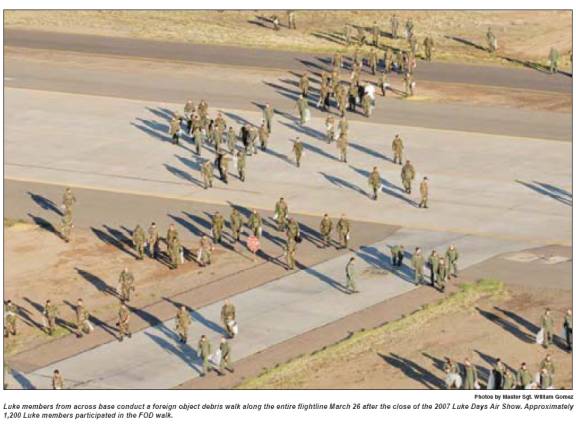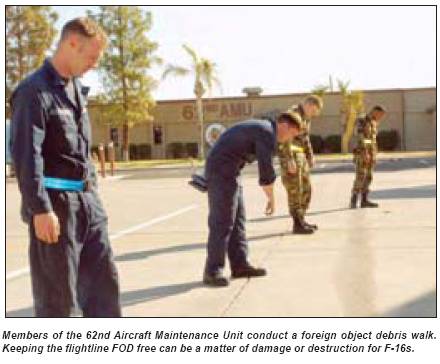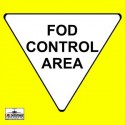It’s one thing when your spouse or roommate bugs you not to leave your clothes on the
floor. However, if someone accidentally leaves a tool or even a pebble on the flightline
near an F-16 ready for takeoff, that oversight could cost the priceless life or limb of a
pilot and part or all of a $20 million Fighting Falcon.
That’s why Foreign Object Debris or Damage prevention is a daily matter of life and
death, and of crucial financial importance at Luke.
Other careless housekeeping scenarios are capable of yielding equally catastrophic
results. The most common FOD mistakes occur inside the cockpit, according to Master
Sgts. Steven Hult and Ryan Boyer, 56th Fighter Wing FOD program monitors.
“If an undetected pencil or small bolt has dropped between the pilot’s seat and the control panel, it could jam the throttle or the ejection seat mechanism,” Sergeant Hult explained.“The F-16’s cockpit is cramped, with several tight-fitting moving parts. If a tiny light bulb or control knob fell into one of those moving parts it could cause an electrical short, or it could chafe through wires and start a fire. Situations like those can cause an in flight emergency.”
Most in flight emergencies do not result in anything more serious than an early
return to landing.
Both Sergeants Boyer and Hult are FOD prevention NCOs. They co-manage the 56th
FW FOD office for NCOs and work with all Luke squadrons and the 56th Maintenance
Group. Sergeant Boyer has 21 years of experience as an engine craftsman, and Sergeant
Hult has more than 16 as a crew chief. They report directly to Col. David Orr, 56th FW
vice commander. Colonel Orr also serves as wing FOD manager.
What is FOD?
FOD is anything that potentially impairs an aircraft’s ability to fly, according to Gary Chaplin, FOD Control Corporation president.
“Tools, nuts or bolts, caps, paper, aircraft parts, vehicles, people, construction material, packaging, plastic bags, dogs, cats, birds, pencils, phones, books, rocks, pavement pieces, aluminum cans, golf balls — the list is as long as the flightline. Just one of these, left in the wrong place one time, can be dangerous.
“That’s what makes it so crucial to identify potential FOD sources, to get and stay
organized to handle FOD and to keep people motivated 100 percent of the time to eliminate it.”
Daily FOD walks
Chief among weapons in the FOD-fighting arsenal is the daily FOD walk. This is
when an entire unit of 30 to 50 Airmen walk side-by-side, canvassing Luke’s runways
and F-16 parking areas that make up the flightline.
Daily FOD walks are conducted by eight aircraft maintenance units, composed of
between 240 and 400 Airmen, who comb Luke’s parking aprons to remove all visible
debris.
The entire flightline is 1,292,322 square yards, which is a lot of ground to cover.
Additionally, pre- and post-flight inspections are conducted on each aircraft, cabin
and engine of Luke’s more than 180 F-16s.
A towable friction mat called the FOD boss also plays an important daily role. It is
used on military and airport preflight runways throughout the nation and overseas.
The FOD boss sweeps and clears ramps and runways of debris as small as a pebble,
which could cause damage if swept into a jet engine.
FOD and tool control bags and covers
Other valuable prevention devices include FOD and tool control bags. Airmen working
on or around the flightline are required to deposit FOD in specially marked bags
whenever they find it. Maintainers store and carry tools in tool control bags. Some bags
can be placed on belts so workers have FOD pouches with them at all times.
Some FOD bags are color-coded and kept in specific work areas. Other bags hold
personal effects like pens and flashlights, so they won’t fall from pockets. Bag covers
are used to keep FOD out of equipment and aircraft parts while work is being done
nearby.
“Our work is an all-encompassing team effort,” Sergeant Boyer said. “FOD prevention and damage control extends to civil engineering, the fire department, the hospital and airfield maintenance and management.”
Sergeants Boyer and Hult take part in quarterly FOD committee meetings chaired
by Colonel Orr and attended by group and squadron commanders and each unit’s FOD
representative.
Some FOD is out of man’s control
Sometimes it is unavoidable when varmints such as coyotes, rats and rabbits appear
unexpectedly and fly into the aircraft or are swept up off the flightline into a jet engine
upon takeoff. After takeoff, when the F-16 is in mid-flight, large birds also can quickly
create havoc when sucked into a jet engine.
“Some FOD incidents are out of man’s control,” Sergeant Boyer said. “But we have procedures in place to try to minimize them and the damage they can cause. Last September, a turkey vulture appeared out of nowhere and flew into the F-16 upon takeoff, causing the pilot to make a forced landing. Fortunately, the pilot followed his procedural checklist and was able to land the F-16 without injury, but more than $21,000 damage was done to the aircraft canopy.”
For more information about FOD and how to fight it, call Sergeant Boyer at (623)
856-7085 or Sergeant Hult at (623) 856-6767.




